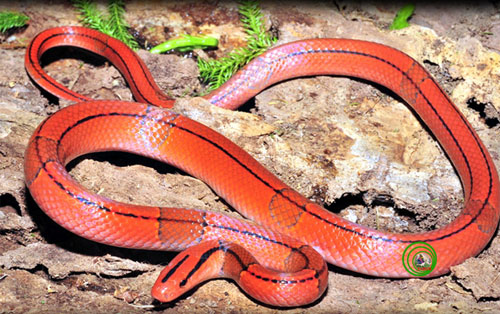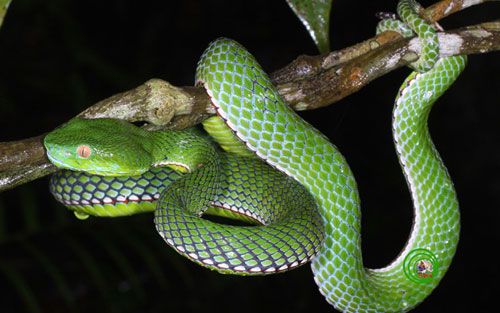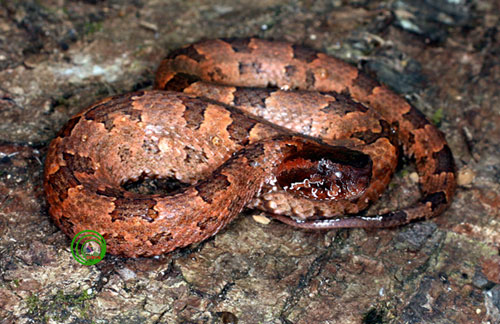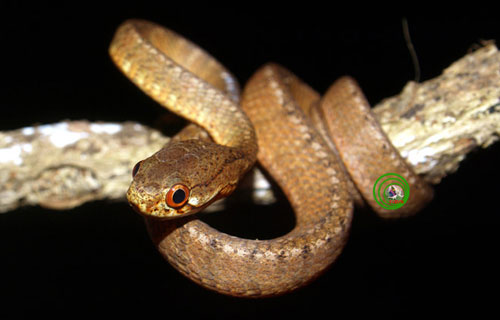The beauty of Vietnamese snakes
For reptiles, snakes are not only beautiful outside, but also an important link, playing an ecological balance in human ecosystems. In Vietnam only about 30 species have deadly venom that lives on land and 22 species of sea snakes.
>>> The poisonous snakes in Vietnam

Oreocryptophis porphyraceus, red spotted stripe snake. Considered one of the most sprawling snakes in Vietnam and also a species that lives in places close to our roof. This species often earns food at the edge of the forest along streams of high mountains. Prefer to operate in the early morning or sunset. Food is mainly amphibians and small rodents. Lay about 2 - 7 eggs. Long-tipped eggs have a tough, white shell. It is because of their brilliant beauty and completely harmless to humans that they have been hunted aggressively for trade and breeding. Currently this species has been included in the Vietnam Red Book.

Southern green snake Viridovipera vogeli. The most sublime and wise night hunter of the snakes is called the southern green snake Viridovipera vogeli. In the middle of the darkness of the tropical rainforest, this green snake uses its heat sensation in the dark night to catch prey. He searched for a small stump curled into branches near the ground and waited patiently for the prey to pass by. With a single bite of its sharp teeth, the prey will not have a chance to escape.

Green snake mountain Ovophis monticola . This is a very poisonous snake for warm-blooded animals, but this color blind man is very naive in daylight, so it is difficult for people to meet them. Day-to-day evasion and nighttime feeding in small puddles in evergreen forests are the most effective way of their ancestors.

Pareas carinatus In Vinh Cuu Nature Reserve when the nighttime temperature drops, the human body has begun to feel the coldness of the night fog falling, it is also when this species crawls out of the cave where it hides during the day to search. eat. Rhacophorus tree frogs and small frog species will be good prey. This species is very rare in the daytime but it is easy to identify this nontoxic snake in the night with a light brown scales, the scales close to the dark brown belly, the outer edge of the eyes glowing red when the light reflected in the night dark. It is a small, shy, large-sized snake, but the number of individuals of this species is not much in nature.

Boiga jaspidea jade fence. The beauty queen of snakes will surely receive votes for the Boiga jaspidea jade snake snake because of the colors and patterns on its body, which are made of harmonious makeup. In the dark the reflection of the colored layers by the flash image made it stand out. Although it is a non-poisonous snake, it is capable of pre-capturing some venomous snakes when threatened by bulging the output to scare the enemy and producing threatening sounds to find a way to hide.

Chrysopelea ornata. This species is about 130cm long, green head with black streaks; chin and above ivory color edge. Their bodies are light greenish yellow. This small and shy snake often uses a method of hiding "hot books" when meeting an enemy. This is said to be their most effective method because of 'knowing ourselves weak'. They work during the day and feed mainly on small lizards.

Red-eyed snakes Trimeresurus stejneger. Slowly, quietly in the darkness covered with evergreen forests, but only one bite of this poisonous snake can kill any animal much larger than it. Its venom attacks cells in the body that cause swelling, necrosis if not treated and if you do not understand the behavior, its way of attack, do not be foolish but let the lens take pictures. it's 2m away unless you don't want to see the sun the next day.

Brown tiger serpent Psammodynastes pulverulentus. The top of the triangle is clear and therefore this brown earth tiger is often mistaken for other venomous snakes, however it is a completely harmless snake. With a floating line running from the eyes to the muzzle, big eyes, pupils standing. Cylindrical body, smooth scales. Background color is brown or light red, light brown belly or pink they are easy to identify in nature although patterns often change according to living habitat to suit hunting and hiding natural enemies. Food is mainly lizards and frogs and they hunt all day and night. Each litter lays from 5 10, the snake snake is 15-1 8cm long, looks like a mature snake. This species is distributed throughout Southeast Asia to Nepal, Taiwan and the Philippines.

Small flower snake Rhabdophis subminiatus. Brightly colored in the head and neck not only make-up for them erotic beauty during mating season, but also help it threaten the enemy. They may be harmless to humans and some other warm-blooded animals but they are nightmares for amphibian cold-blooded species in the forests. This species is often distributed at low altitudes and the darkness always accompanies it in finding food and finding partners during mating season. Recently scientists have discovered that this species has poison accumulated in the body when they eat poisonous species.

Solid head deviation Dinodon meridionale. The tongue protruding, indented by most snakes not only aims to threaten enemies, but also helps them to sniff out prey, as well as weather because most snakes are heavy myopia, especially in the dark night. and to attack the prey or the snake's instinct is inherited by shrinking and sprinting, thrusting forward to bite the prey. Dinodon meridionale, too, is considered the king of speed when he makes an unpredictable move.

Striped striped snake Elaphe mandarina . The Creator has bestowed this serpent snake with a color and the most beautiful patterns in the snake family in our country. This venomous snake has a head that does not distinguish itself from the neck. The back is pink, the middle of the neck and back has a series of black fillings, in the middle there is a yellow stain. There is a dark gray mark running across the muzzle, a second mark runs across the top of the head through the eyes, a third stain forms an L shape at the nape of the neck. Yellow belly has big dark gray streaks staggered against each other. Live in the forest by the stream or in the grass on the hills, mountains, mainly rodent food, lizards. Lay about 5 - 10 eggs. Long-tipped eggs have a tough, white shell. Because of their vibrant colors, they are exploited, hunted and exhausted to serve the demand of ornamental and export. This species has now been included in the red book to protect its survival in the wild.

Cobra snake Pseudoxenodon macrops. The most disguised and fraudulent of snakes in Vietnam. The snake snakes its eyes when threatened, this harmless snake snatches its head, neck, and bulges its neck to mimic the appearance of a naja naja cobra that fights its enemies. Snake head is different; Big eyes with round pupils. The cylindrical body has raised scales. There is a black line on the V-neck and the top is on the head. Brown head and body turn gray. There are pale yellow or light red spots along the abdomen edge and black round spots on both sides of the body. The snake-faced snake usually lives in dense forests near streams and at an altitude of about 150 to 200m above sea level. The main food of this species is frog and frog. Each litter lays about 10 eggs.

Two-headed Snake Calamaria septentrionalis. The head and tail are very similar, the pattern on its body is made of makeup very harmoniously, this is the ultimate weapon to escape from this snake. When attacked by enemies they are difficult to distinguish, where the head is and where the tail is at the time the darkness has covered the forest, so their chances of escape are great. This species often lives under the vegetation litter and their food is soil insects such as ants, young fat termites. In the dark the reflection of the stained layers by the flash image made it stand out but in the daylight their colors were only a gray.

Green snake jerdoni Protobothrops jerdonii. The bright yellow scales are arranged in great detail to form a closed and prominent pattern on black branched scales. The snakes are slow, quietly in the darkness of the alpine evergreen forests on the roof of Vietnam Hoang Lien Son Mountains. But only one bite of this poisonous snake can kill any animal much larger than it. Its venom attacks cells in the body that cause edema and necrosis if left untreated.

Black snake dragon Sibynophis collaris. Escaping, the book of high-quality books when meeting enemies is the most effective method of this small and shy snake. Although it is an active, daytime species, the food of this species is known only as fat dairy termites in plant litter. Occasionally encountering Sphenomorphus lizards, it is also powerful in spite of its limited capacity. This is a snake that has no chance of being encountered in nature for even researchers because it rarely escapes the dense vegetation of the evergreen forests, because it does not want to be a prey. for others.

Dryocalamus davisoni. At first glance, it is easy to mistake this snake-climbing snake with the highly poisonous Bungarus candidus snake, which usually lives in vegetation thanks to its ability to capture prey to every detail of the snake that is considered harmless. this. But if you are not a snake expert, you should not underestimate if you are not sure if they are Dryocalamus davisoni, before you intend to take a picture. The most suitable place for him to eat and hide is the dry blossoms of the trees that are crushed by the multi-strangled species or the old saplings along the stream.
- 'Terrifying beauty' of colorful snakes
- Poisonous snakes in Vietnam
- See 'deadly beauty' of poisonous snakes
- 4 most poisonous snakes found in Fansipan
- How to distinguish hot and hard snakes
- The beauty of Vietnamese women in the past and now
- A new species of snakes is found in Laos
- The truth about 11 extremely poisonous snakes in the world
- Strange little known about snakes
- 7 snakes look scary ... but harmless to humans
- Find a new snake, but no one can find it
- Mysterious answers about snakes and canines
 Animal 'suffering' after hibernation
Animal 'suffering' after hibernation Why do goats climb well?
Why do goats climb well? Scientists were surprised to see chimpanzees eating turtles
Scientists were surprised to see chimpanzees eating turtles Giant catfish died deadly due to drought in Thailand
Giant catfish died deadly due to drought in Thailand